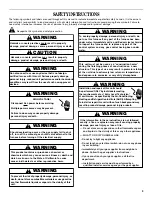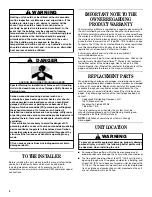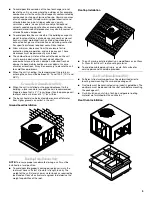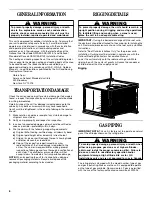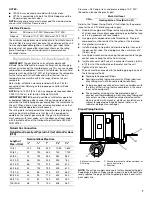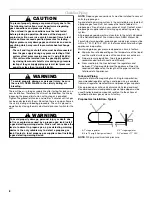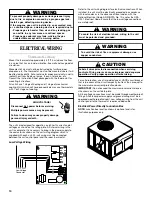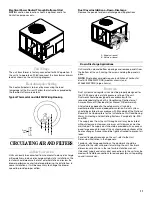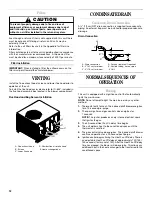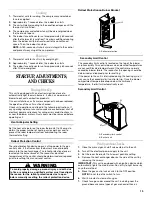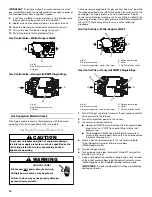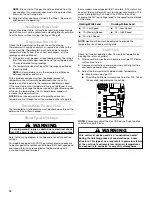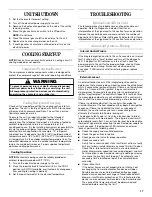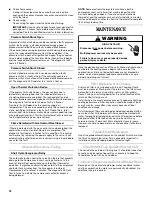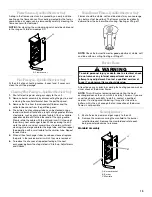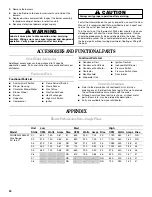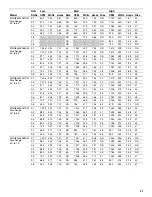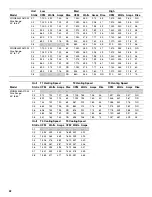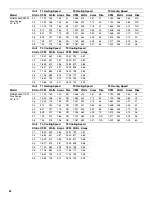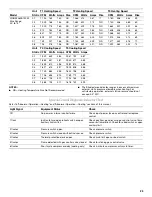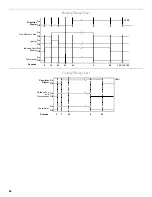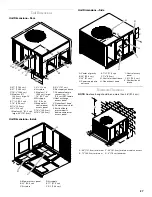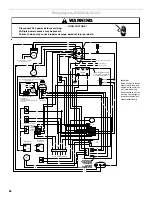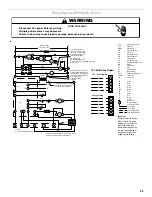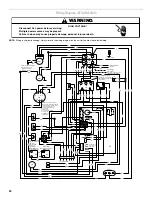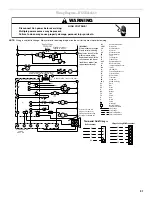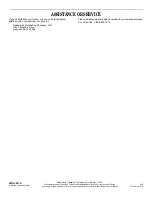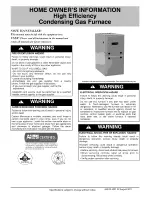
17
UNIT SHUTDOWN
1. Set the thermostat to lowest setting.
2. Turn off the electrical power supply to the unit.
3. Remove the heat exchanger door on the side of the unit by
removing screws.
4. Move the gas control valve switch to the Off position.
NOTE: Do not force.
5. Close the manual gas shutoff valve external to the unit.
6. Replace the heat exchanger door on the unit.
7. If cooling and/or air circulation will be desired, turn on the
electrical power.
COOLING START-UP
NOTE: Check all manual reset limit controls in heating circuit if
cooling mode does not operate.
Compressor Protection Devices
The compressor includes components which are designed to
protect the compressor against abnormal operating conditions.
Cooling Refrigerant Charging
Check unit charge before putting the cooling section into full
operation. The unit is factory charged with R-410A for nominal
airflow and static pressure conditions. The unit has a piston
flowrator expansion device.
To ensure the unit is properly charged for the intended
application, check the unit refrigerant superheat at the
compressor. The refrigerant superheat is a function of outdoor
ambient temperature and return air temperature of the
conditioned space. It is the installing contractors responsibility to
ensure the proper refrigerant superheat at the compressor is
adjusted for each application. For example, 10º refrigerant
superheat level is adequate for a 95ºF (35ºC) outdoor ambient
temperature and a 78ºF to 80ºF (26ºC to 27ºC) for indoor return
air temperature. As the outdoor ambient temperature rises, the
superheat decreases and as the outdoor ambient temperature
lowers the superheat increases. Proper superheat adjustment
optimizes cooling performance.
Cooling Operation
NOTE: Mechanical cooling cannot be reliably provided at
ambient temperatures below 50°F (10ºC).
1. Turn on the electrical power supply to the unit.
2. Place the room thermostat selector switch in the COOL
position (or AUTO if available, and if automatic changeover
from cooling to heating is desired).
3. Set the room thermostat to the desired temperature.
TROUBLESHOOTING
Ignition Control Error Codes
The following presents probable causes of questionable unit
operation. Refer to Diagnostic Indicator Chart for an
interpretation of the signal and to this section for an explanation.
Remove the control box access panel and note the number of
diagnostic LED flashes. Refer to Diagnostic Indicator Chart for an
interpretation of the signal and to this section for an explanation.
Abnormal Operation—Heating
Internal Control Failure
If the integrated ignition control in this unit encounters an internal
fault, it will go into a “hard” lockout and turn off the diagnostic
LED. If diagnostic LED indicates an internal fault, check the
power supply to the unit for the proper voltage, check all fuses,
circuit breakers and wiring. Disconnect electric power for
5 seconds. If LED remains off after restoring power, replace
control.
External Lockout
An external lockout occurs if the integrated ignition control
determines that a measurable combustion cannot be established
within 3 consecutive ignition attempts. If flame is not established
within the 7-second trial for ignition, the gas control valve is
de-energized, 15-second inter-purge cycle is completed, and
ignition is reattempted. The control will repeat this routine 3 times
if a measurable combustion is not established. The control will
then shut off the induced draft blower and go into a lockout state.
If flame is established but lost, the control will energize the
circulator blower at the heat speed and then begin a new ignition
sequence. If flame is established then lost on subsequent
attempts, the control will recycle for 4 consecutive ignition
attempts (5 attempts total) before locking out.
The diagnostic fault code is 1 flash for a lockout due to failed
ignition attempts or flame dropouts. The integrated control will
automatically reset after 1 hour, or it can be reset by removing the
thermostat signal or disconnecting the electrical power supply for
over 5 seconds. If the diagnostic LED indicates an external
lockout, perform the following checks:
■
Check the supply and manifold pressures.
■
Check the gas orifices for debris.
■
Check gas control valve for proper operation.
■
Check secondary limit.
A dirty filter, excessive duct static, insufficient airflow, a faulty
limit or a failed circulator blower can cause this limit to open.
Check filters, total external duct static, circulator blower
motor, blower motor speed tap (see wiring diagram) and limit.
An interruption in electrical power during a heating cycle may
also cause the auxiliary limit to open. The automatic reset
secondary limit is located on top of the circulator blower
assembly.
■
Check rollout limit.
If the burner flames are not properly drawn into the heat
exchanger, the flame rollout protection device will open.
Possible causes are restricted or blocked flue passages,
blocked or cracked heat exchanger, a failed induced draft
blower or insufficient combustion air. The rollout protection
device is a manual reset limit located on the burner bracket.
The cause of the flame rollout must be determined and
corrected before resetting the limit.
To prevent personal injury or death, always disconnect
electrical power before inspecting or servicing the unit.
All compressor protection devices reset automatically,
energizing the contactor and outdoor fan.
WARNING

